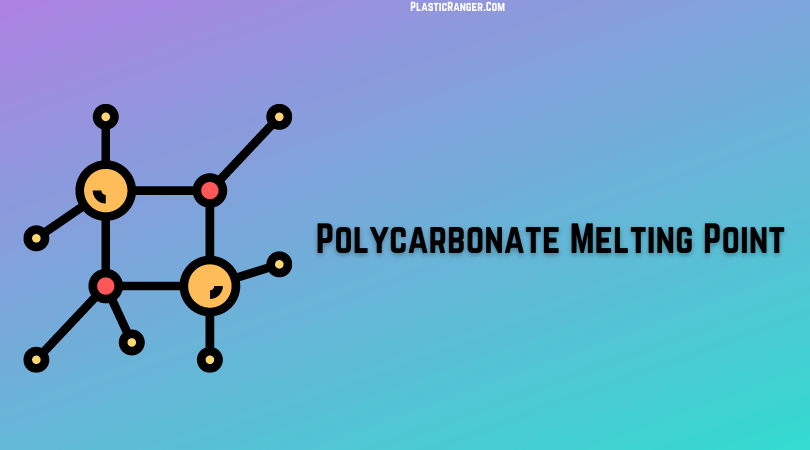Polycarbonate Melting Point
| Material | Polycarbonate |
| Structure | Amorphous |
| Chemical Formula | C15H16O2 |
| Melting Point | 288-316 °C (550-600 °F) |
| Young’s Modulus | 2.0–2.4 GPa |
| Specific Gravity | 1.19 |
| Tensile Strength | 59 MPa (8500 PSI) |
| Shrinkage | 0.6 – 0.9 % (.006 – .009 in/in |
| Mold Temperature | 82 – 121 °C (180 – 250 |
| Service temperature | 140 °C (284 °F) at 0.46 MPa (66 PSI) |
Heat Deflection Temperature | 0.45 MPa: 140 °C (284 °F) 1.8 MPa: 128–138 °C (262–280 °F) |
| Flexural Strength | 93 MPa (13500 PSI) |
| Density (ρ) | 1.20–1.22 g/cm3 |
| Compressive Strength | >80 MPa
|
Polycarbonate’s melting point is typically between 288°C to 316°C. For instance, the melting point of polycarbonate based on bisphenol A (PC-BPA) is approximately 265°C, while the same for polycarbonate based on bisphenol S (PC-BPS) is about 309°C.
Polycarbonate is a versatile thermoplastic polymer widely used in various applications due to its strength, toughness, and transparency.
The melting point of polycarbonate is an essential physical property that influences its processing, performance, and end-use applications.
These values may vary slightly depending on the specific polycarbonate resin and its formulation.
The melting point of polycarbonate depends on several factors, such as molecular weight, degree of crystallinity, and impurities.
Polycarbonate, with a higher molecular weight and degree of crystallinity, generally has a higher melting point.
Impurities, conversely, can lower the melting point by disrupting its crystal structure.
How Polycarbonate Melting Point Affects Its Density
Polycarbonate exhibits an exciting relationship between its melting point and density. As the polymer transitions from solid to liquid, its molecules’ regular, orderly packing loosens, typically decreasing density, as with most substances.
However, one must acknowledge that this transformation is not invariably linear for polymers such as polycarbonate.
The polycarbonate structure, their intermolecular interplay, and the incorporation of additives may markedly modulate the material’s comportment during the melting process.
Furthermore, upon being cooled and solidified, the density of polycarbonate may be subject to alterations contingent upon the cooling pace, which could engender varying degrees of crystallinity.
Hence, while the melting point signifies a pivotal metamorphosis for polycarbonate, the correlation between this particular temperature and polycarbonate density is multifaceted, swayed by a gamut of elements tied to the material’s intrinsic characteristics and processing circumstances.
Thus, comprehending this relationship is indispensable for the optimal utilization of polycarbonate in a plethora of applications.
Advantages
Durability: Polycarbonate is highly impact-resistant and can withstand high stress and strain.
Lightweight: Polycarbonate is lighter than glass, making it easy to handle and install.
Transparency: Polycarbonate is highly transparent, allowing for good visibility.
UV resistance: Polycarbonate has built-in UV protection that prevents yellowing and deterioration over time.
Fire resistance: Polycarbonate has high fire resistance, making it ideal for various applications.
Versatility: Polycarbonate can be molded into various shapes and sizes, making it suitable for multiple applications.
Disadvantages
Cost: Polycarbonate is more expensive than other plastic materials, such as PVC or acrylic plastic.
Scratching: Polycarbonate can scratch easily, making it less suitable for frequent cleaning applications.
Flammability: Polycarbonate can be flammable and may not be suitable for applications where fire safety is a concern.
Applications
Safety Glass: Polycarbonate is used as a substitute for cars, bulletproof windows, and security shields.
Electronics: Polycarbonate is used to manufacture electronics such as smartphones, laptops, and televisions.
Architecture: Polycarbonate is used for skylights, greenhouse panels, and exterior glazing applications in architecture.
Sports Equipment: Polycarbonate produces various sports equipment, such as hockey masks, football helmets, and lacrosse sticks.
Medical Devices: Polycarbonate manufactures medical devices, including prescriptive lenses, eye shields, protective face shields, and dental guards.
Conclusion
Polycarbonate melting point is an important physical property that affects its processing, performance, and end-use applications. Understanding the melting point of polycarbonate is crucial for selecting the appropriate polycarbonate resin for specific applications and optimizing the processing and performance of polycarbonate-based products.
Quick Navigation

